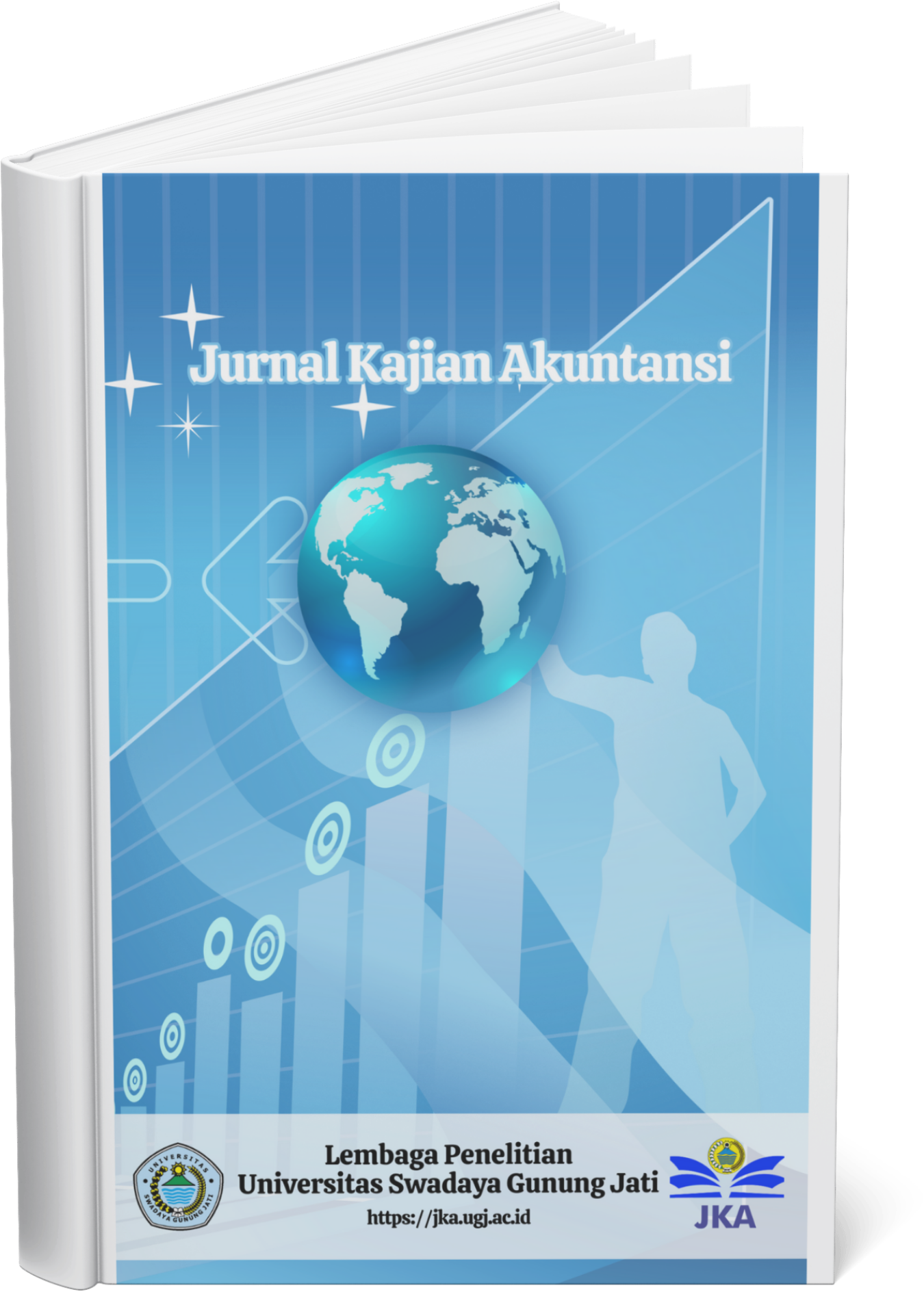Keluarga dalam Bisnis dan Biaya Utang: Bukti dari Perusahaan Keluarga di Indonesia
DOI:
https://doi.org/10.33603/jka.v8i1.9281Kata Kunci:
Biaya utang, Data panel, Keterlibatan keluarga, Perusahaan keluargaAbstrak
Isu efisiensi dalam memilih pendanaan menjadi perhatian para peneliti, terlebih selama pandemic covid 19. Penelitian kami berupaya menginvestigasi apakah keterlibatan keluarga dalam bentuk kepemilikan berkontribusi terhadap struktur pendanaan perusahaan keluarga dan meningkatkan efisieni dalam pendanaan. Kemudian kami juga memperluas pengujian untuk melihat bagaimana aktivitas manajemen laba mempengaruhi keterlibatan keluarga tersebut. Kami mengumpulkan perusahaan keluarga yang terdaftar di Bursa Efek Indonesia selama periode 2005-2020. Kemudian kami menganalisis data dengan menggunakan regresi data panel. Hasil penelitian memberikan bukti empiris yang cukup kuat bahwa keterlibatan keluarga dan kepemilikan keluarga dalam manajemen mapu menurunkan dan memberikan efisiensi dalam pendanaan dari skema utang selama pandemic covid 19. Hasil penelitian kami juga memberikan bukti empiris bahwa manajemen laba yang dilakukan melalui arus kas abnormal tidak mempengaruhi keterlibatan dan kepemilikan keluarga dalam berkontribusi menurunkan biaya utang. Penelitian ini diharapkan memberikan implikasi yang cukup luas bagi perusahaan keluarga terutam adlaam menentukan keputusan pendanaan dari skema utang.
Referensi
Berrone, P., Cruz, C., & Gomez-Mejia, L. R. (2012). Socioemotional Wealth in Family Firms: Theoretical Dimensions, Assessment Approaches, and Agenda for Future Research. Family Business Review, 25(3), 258–279. https://doi.org/10.1177/0894486511435355.
Brahmono, A. Y. A., & Purwaningsih, A. (2022). Real Earnings Management Practices in Indonesia: Opportunist or Efficient Earnings Management Practices? Review of Integrative Business and Economics Research, 11(1), 191–200.
Callen, J. L., & Chy, M. (2023). The agency costs of investment opportunities and debt contracting: Evidence from exogenous shocks to government spending. Journal of Business Finance and Accounting, October, 1–31. https://doi.org/10.1111/jbfa.12769.
Cheng, B., Ioannou, I., & Sarafeim, G. (2014). Corporate social responsibility and access to finance. Strategic Management Journal, 35(1), 1–23. https://doi.org/10.1002/smj.
Doucouré, B., & Diagne, A. (2020). The effect of size and age on the performance of Senegalese small food companies: the role of market orientation. Transnational Corporations Review, 12(4), 363–373. https://doi.org/10.1080/19186444.2020.1832426.
Duréndez, A., Madrid-Guijarro, A., & Hernández-Cánovas, G. (2019). Do Family Firms’ Specific Governance Mechanisms Moderate the Cost of Debt? Australian Accounting Review, 29(1), 49–63. https://doi.org/10.1111/auar.12217.
Gao, H., He, J., Li, Y., & Qu, Y. (2020). Family control and cost of debt: Evidence from China. Pacific Basin Finance Journal, 60(December 2019), 101286. https://doi.org/10.1016/j.pacfin.2020.101286.
Ghardallou, W. (2022). Capital Structure Decisions and Corporate Performance: Does Firm’s Profitability Matter? Journal of Scientific and Industrial Research, 81(8), 859–865. https://doi.org/10.56042/jsir.v81i08.59697.
Hillier, D., Martínez, B., Patel, P. C., Pindado, J., & Requejo, I. (2018). Pound of flesh? debt contract strictness and family firms. Entrepreneurship: Theory and Practice, 42(2), 259–282. https://doi.org/10.1177/1042258717748933.
Jensen, M. C., & Meckling, W. H. (1976). Theory of The Firm Manajerial Behaviour, Ageny Cost and Ownership structure. Journal of Financial Economics, 3, 305–360.
Li, J., Wu, Z., & Zhang, L. (2021). Family involvement, external auditing, and the cost of debt: Evidence from U.S. small firms. Journal of Small Business Management, 59(4), 675–699. https://doi.org/10.1111/jsbm.12519.
Li Xi. (2015). Accounting Conservatism and the Cost of Capital : An International Analysis. Journal of Business Finance and Accounting, 42(7), 555–582. https://doi.org/10.1111/jbfa.12121.
Muttakin, M. B., Mihret, D., Lemma, T. T., & Khan, A. (2020). Integrated reporting, financial reporting quality and cost of debt. International Journal of Accounting and Information Management, 28(3), 517–534. https://doi.org/10.1108/IJAIM-10-2019-0124.
Palea, V., & Drogo, F. (2020). Carbon emissions and the cost of debt in the eurozone: The role of public policies, climate-related disclosure and corporate governance. Business Strategy and the Environment, 29(8), 2953–2972. https://doi.org/10.1002/bse.2550.
Pratama, A., Yadiati, W., & Jaenudin, E. (2024). Ownership structures, company size and age, and sustainable development goals are disclosed in the annual report: Is it acceptable to investors? (Survey among publicly listed companies in Indonesia). International Journal of Innovative Research and Scientific Studies, 7(1), 166–179. https://doi.org/10.53894/ijirss.v7i1.2595.
Roychowdhury, S. (2006). Earnings management through real activities manipulation. Journal of Accounting and Economics, 42(3), 335–370. https://doi.org/10.1016/j.jacceco.2006.01.002.
Rudiawarni, F. A., Sulistiawan, D., & Feliana, Y. K. (2017). When is earnings management really good news? Evidences from Indonesia. International Journal of Trade and Global Markets, 10(1), 47–57. https://doi.org/10.1504/IJTGM.2017.082375.
Santos, M. S., Moreira, A. C., & Vieira, E. S. (2014). Ownership concentration, contestability, family firms, and capital structure. In Journal of Management and Governance (Vol. 18, Issue 4). https://doi.org/10.1007/s10997-013-9272-7.
Shailer, G., & Wang, K. (2015). Government ownership and the cost of debt for Chinese listed corporations. Emerging Markets Review, 22, 1–17. https://doi.org/10.1016/j.ememar.2014.11.002.
Swanpitak, T., Pan, X., & Suardi, S. (2020). Family control and cost of debt: Evidence from Thailand. Pacific Basin Finance Journal, 62(June), 101376. https://doi.org/10.1016/j.pacfin.2020.101376.
Tabassum, N., Kaleem, A., & Nazir, M. S. (2015). Real Earnings Management and Future Performance. Global Business Review, 16(1), 21–34. https://doi.org/10.1177/0972150914553505.
Vander Bauwhede, H., De Meyere, M., & Van Cauwenberge, P. (2015). Financial reporting quality and the cost of debt of SMEs. Small Business Economics, 45(1), 149–164. https://doi.org/10.1007/s11187-015-9645-1.
Wang, G., Bai, J., Xing, J., Shen, J., Dan, E., Zheng, X., Zhang, L., Liu, P., & Feng, R. (2023). Operational Efficiency and Debt Cost: The Mediating Effect of Carbon Information Disclosure in Chinese Listed Companies. Sustainability (Switzerland), 15(2), 1–18. https://doi.org/10.3390/su15021512.
Unduhan
Diterbitkan
Cara Mengutip
Terbitan
Bagian
Lisensi
- Authors retain copyright and grant the journal right of first publication with the work simultaneously licensed under a Creative Commons Attribution-ShareAlike (CC-BY-SA 4.0) that allows others to share the work with an acknowledgment of the work's authorship and initial publication in this journal.
- Authors are able to enter into separate, additional contractual arrangements for the non-exclusive distribution of the journal's published version of the work (e.g., post it to an institutional repository or publish it in a book), with an acknowledgment of its initial publication in this journal.
- Authors are permitted and encouraged to post their work online (e.g., in institutional repositories or on their website) prior to and during the submission process, as it can lead to productive exchanges, as well as earlier and greater citation of published work.
